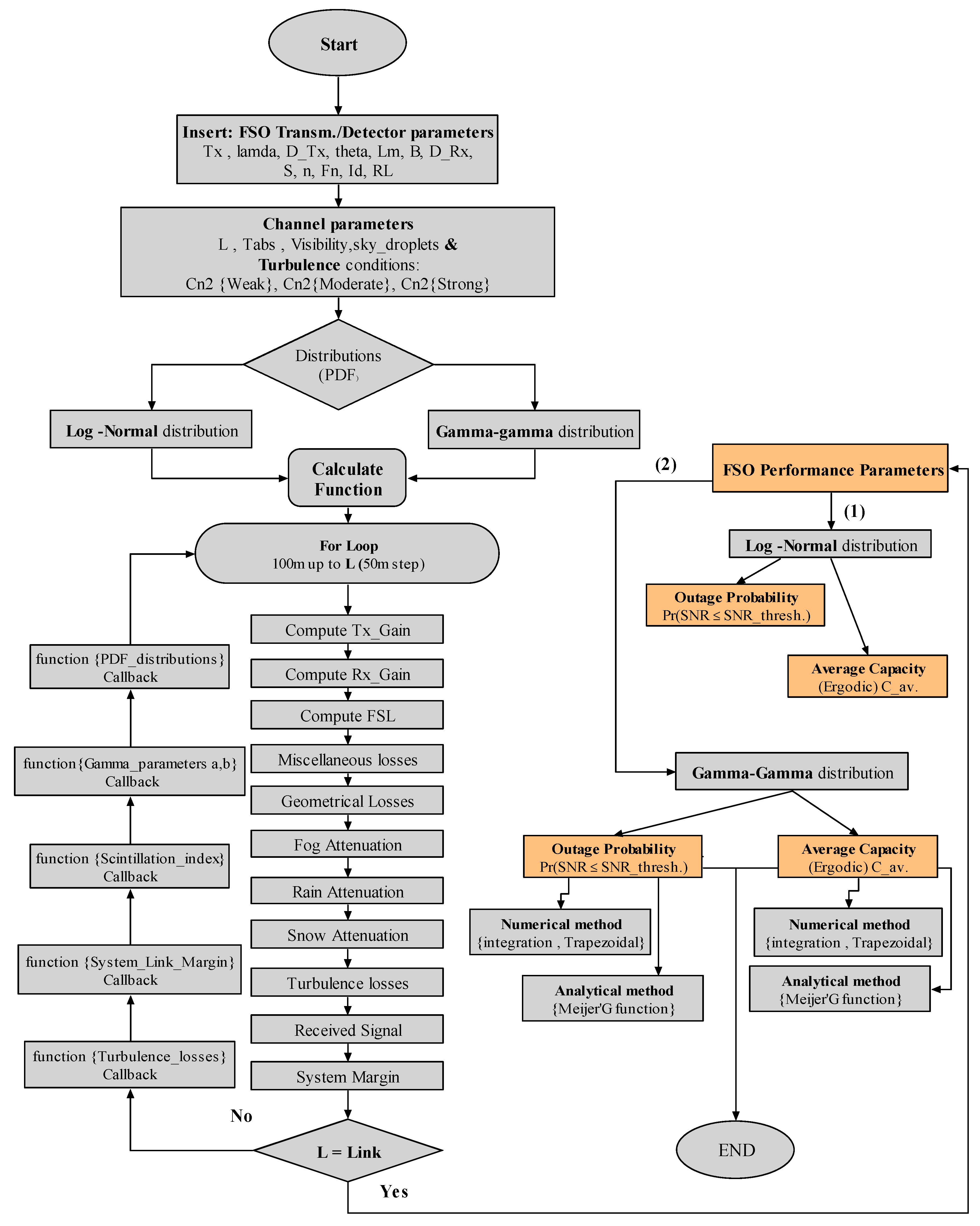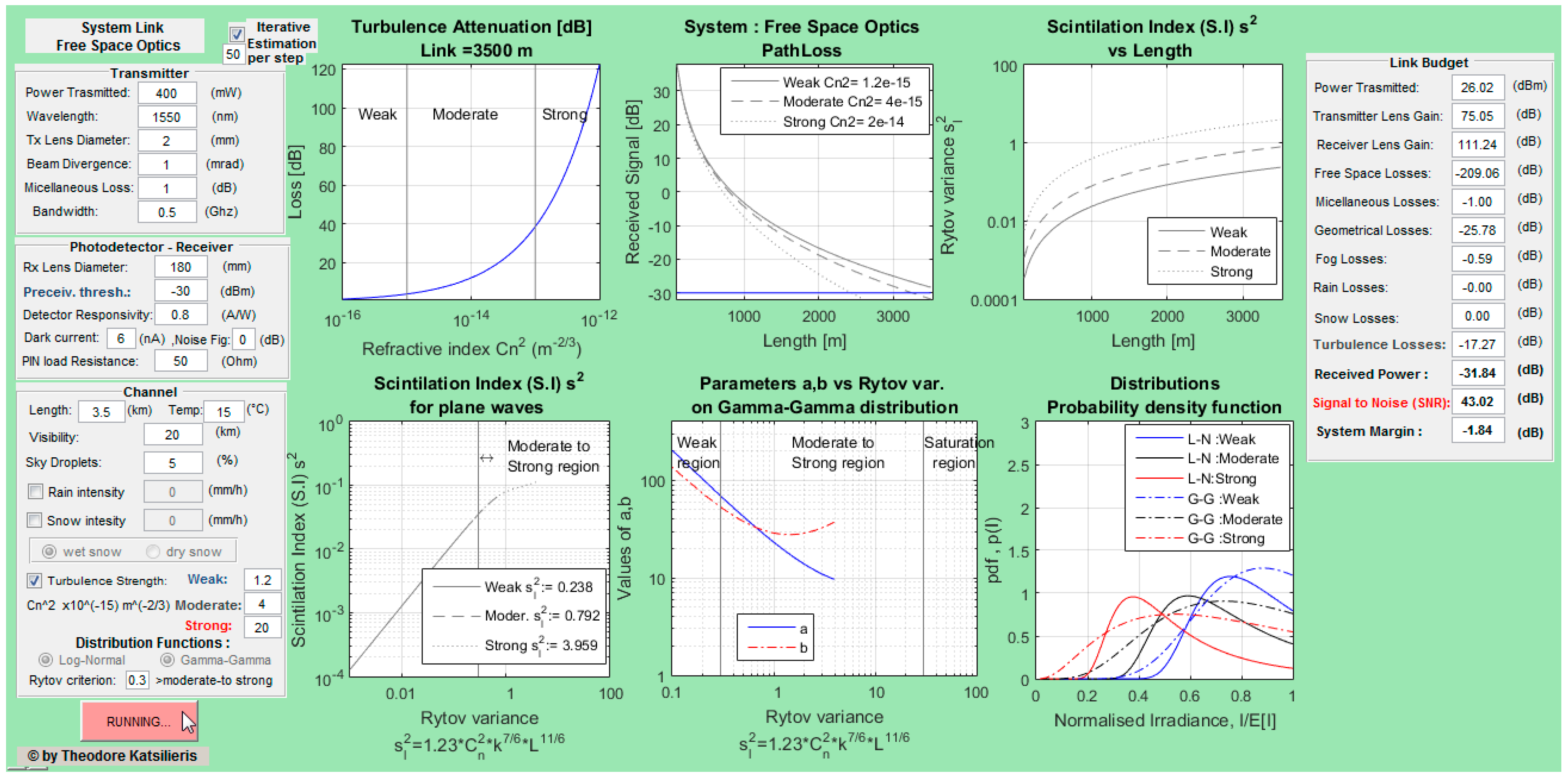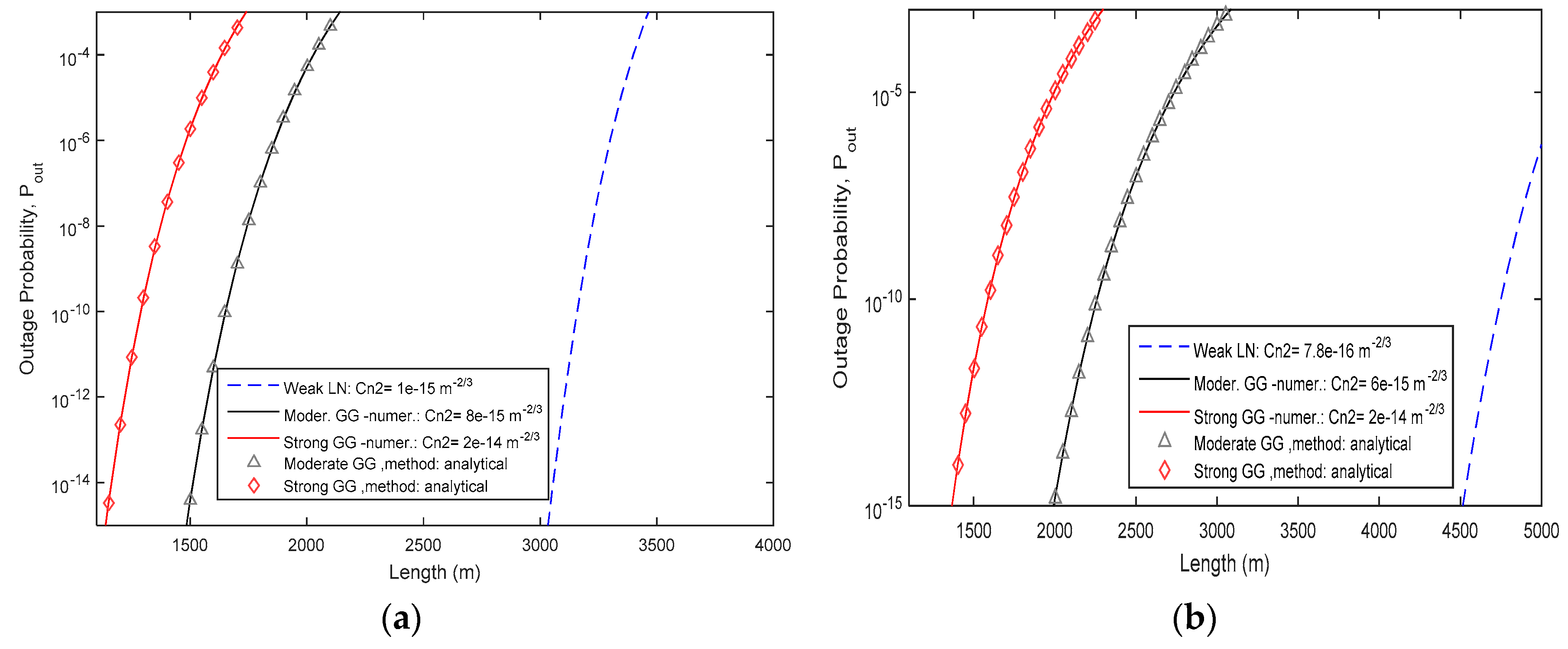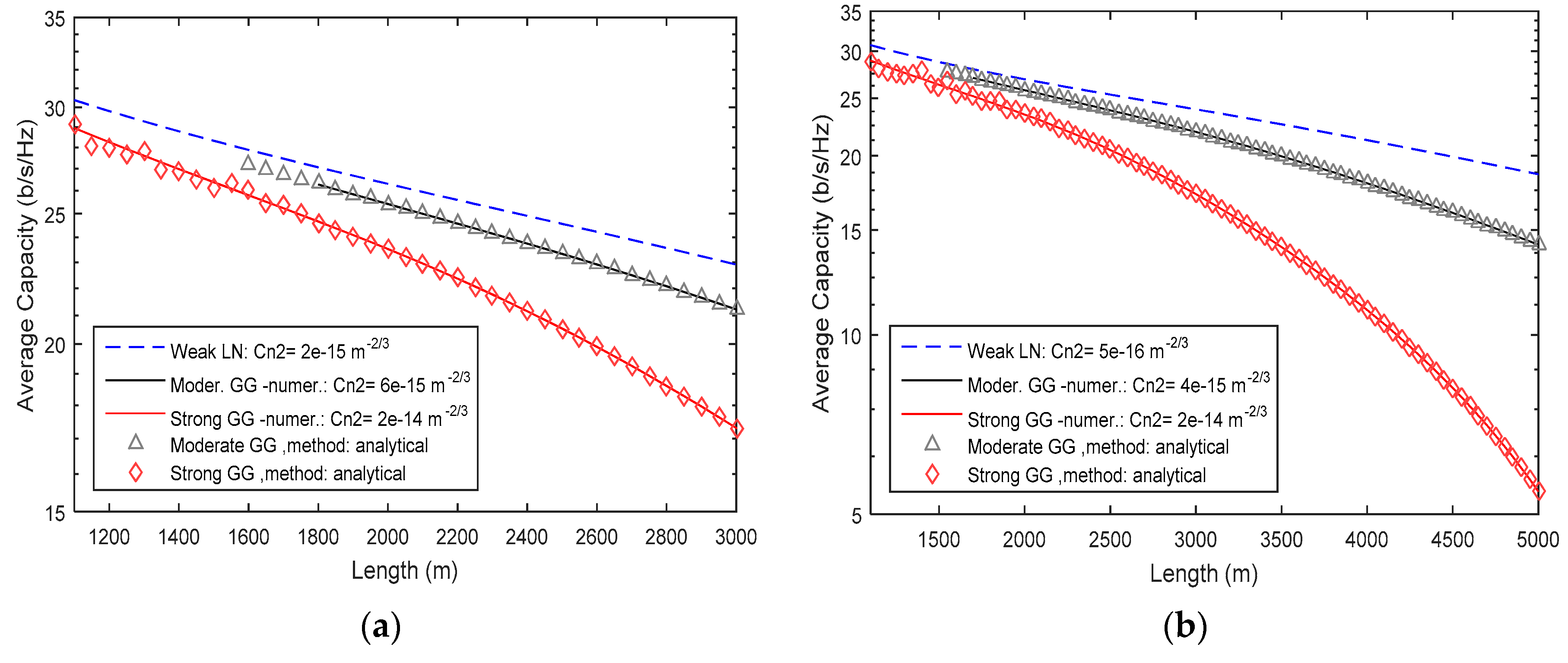An Accurate Computational Tool for Performance Estimation of FSO Communication Links over Weak to Strong Atmospheric Turbulent Channels
Abstract
:1. Introduction
2. Channel Model
2.1. Lognormal Turbulence Model
2.2. Gamma–Gamma Turbulence Model
3. Performance of the FSO System
3.1. Outage Probability of the System
3.2. Average Channel Capacity
4. Algorithm Structure for the Computational Tool
5. Numerical Results
6. Conclusions
Author Contributions
Conflicts of Interest
Appendix A
| Algorithm A1. Outage Probability on Gamma—Gamma Distribution |
| Require: Received signal Equation (6) Pr; parameters a, b from Equation (13); the receiver sensitivity thresh as clear value not in dBm; the number of lengths N that we simulate until achieving the final path; |
| fgg=@(x,aa,bb,xm) %implement the Equation (14) as a function of x, aa, bb ,xm parameters |
| for i1=1 to 3 do % i1 the number of 3 conditions that we study like weak, moderate, strong |
| for i=1 to N do %Loop until achieve the final path |
| X=logspace(−10,10,10000) %create the regions for numerical method trapezoidal |
| Ftrapez = fgg(X,a(i,i1),b(i,i1),Pr(i,i1)) % the trapez function |
| Pout_trapez(i,i1)=trapz(X,ftrapez) %the Outage probability with numerical method of trapezoidal |
| Pout_integ(i,i1)=integral(@(x)fgg(x,a,b,Pr(i,i1)),0,thresh) %the integration method of outage probability with regions from 0 to thresh |
| end |
| find first element >=10−20 of Pout_integ that is j to avoid any chances of getting stuck in the Meijer implementation below and update i with j |
| for i to N do %Loop until achieve the final path |
| A=a(i1)+b(i1)/2, B= a(i1)+b(i1)/2,C=b(i)-a(i) |
| K=((a*b)^A)/(gamma(a)*gamma(b)) |
| K1(i)=(thresh / Pr(i,i1))^A/2 , z= a(i1)* b(i1) *(√ thresh / Pr(i,i1)) |
| Gmeijer(i)= meijerG((2,1,[1-A],[B,C,-A],a*b),z) %the analytical method by meijer function in eq(18) |
| Pout_mejer(i,i1)= K1(i)*K*Gmeijer(i) % Outage probability by analytical method |
| end |
| end |
| Output: Pout_trapez, Pout_int,Pout_mejer . |
References
- Ghassemlooy, Z.; Popoola, W.O. Terrestrial Free-Space Optical Communications. In Mobile and Wireless Communications: Network Layer and Circuit Level Design, 1st ed.; Fares, S.A., Adachi, F., Eds.; InTech: Rijeka, Coatia, 2010. [Google Scholar]
- Henniger, H.; Wilfert, O. An Introduction to Free-Space Optical Communications. Radioengineering 2010, 19, 203–212. [Google Scholar]
- Majumdar, A.K. Advanced Free Space Optics (FSO): A System Approach, 1st ed.; Springer Series in Optical Sciences: New York, NY, USA, 2015; Volume 186. [Google Scholar] [CrossRef]
- Khalighi, M.A.; Uysal, M. Survey on Free Space Optical Communication: A Communication Theory Perspective. IEEE Commun. Surv. Tutor. 2014, 16, 2231–2258. [Google Scholar] [CrossRef]
- Michael, S.; Parenti, R.R.; Walther, F.G.; Volpicelli, A.M.; Moores, J.D.; Wilcox, W.J.; Murphy, R. Comparison of scintillation measurements from 5 km communications link to standard statistical models. In SPIE Atmospheric Propagation VI; Thomas, L.M.W., Gilbreath, G.C., Eds.; SPIE: Orlando, FL, USA, 2009; Volume 7324, ISBN 9780819475909. [Google Scholar]
- Libich, J.; Zvanovec, S. Measurements Statistics of three joint wireless optical links. In Proceedings of the International Workshop on Optical Wireless Communications (IWOW), Pisa, Italy, 22 October 2012.
- Perez, J.; Zvanovec, S.; Ghassemlooy, Z.; Popoola, W.O. Experimental characterization and mitigation of turbulence induced signal fades within an ad hoc FSO network. Opt. Soc. Am. 2014, 22. [Google Scholar] [CrossRef] [PubMed]
- Mazin, A.A.A. Performance Analysis of the Fog Effect on Free Space Optical Communication System. IOSR J. Appl. Phys. (IOSR-JAP) 2015, 7, 16–24. [Google Scholar]
- Popoola, W.O.; Ghassemlooy, Z.; Leitgeb, E. BER and Outage Probability of DPSK Subcarrier Intensity Modulated Free Space Optics in Fully Developed Speckle. J. Commun. 2009, 4, 546–554. [Google Scholar] [CrossRef]
- Sandalidis, H.G.; Tsiftsis, T.A.; Karagiannidis, G.K. Optical wireless communications with heterodyne detection over turbulence channels with pointing errors. J. Lightwave Technol. 2009, 27, 4440–4445. [Google Scholar] [CrossRef]
- Gappmair, W. Novel results on pulse-position modulation performance for terrestrial free-space optical links impaired by turbulent atmosphere and pointing errors. IET Commun. 2012, 6, 1300–1305. [Google Scholar] [CrossRef]
- Gappmair, W.; Hranilovic, S.; Leitgeb, E. Performance of PPM on Terrestrial FSO Links with Turbulence and Pointing Errors. IEEE Commun. Lett. 2010, 14, 468–470. [Google Scholar] [CrossRef]
- Laourine, A.; Stephenne, A.; Affes, S. Estimating the Ergodic Capacity of Log Normal Channels. IEEE Commun. Lett. 2007, 11, 568–570. [Google Scholar]
- Epple, B. Simplified channel model for simulation of free-space optical communications. IEEE/OSA J. Opt. Commun. Netw. 2010, 2, 293–304. [Google Scholar] [CrossRef]
- Peppas, K.P.; Stassinakis, A.N.; Topalis, G.K.; Nistazakis, H.E.; Tombras, G.S. Average Capacity of Optical Wireless Communication Systems Over I-K Atmospheric Turbulence Channels. IEEE/OSA J. Opt. Commun. Netw. 2012, 4, 1026–1032. [Google Scholar] [CrossRef]
- Andrews, L.C.; Phillips, R.L. I-K distribution as a universal propagation model of laser beams in atmospheric turbulence. J. Opt. Soc. Am. A 1985, 2, 160–163. [Google Scholar] [CrossRef]
- Al-Habash, M.A.; Andrews, L.C.; Phillips, R.L. Mathematical model for the irradiance probability density function of a laser beam propagating through turbulent media. Opt. Eng. 2001, 40, 1554–1562. [Google Scholar] [CrossRef]
- Kamalakis, T.; Sphicopoulos, T.; Muhammad, S.S.; Leitgeb, E. Estimation of the power scintillation probability density function in free-space optical links by use of multicanonical Monte Carlo sampling. Opt. Lett. 2006, 31, 3077–3079. [Google Scholar] [CrossRef] [PubMed]
- Garrido, J.M.; Balsells, A.; Jurado-Navas, J.; Paris, F.; Castillo-Vasquez, M.; Puerta-Notario, A. On the capacity of M-distributed atmospheric optical channels. Opt. Lett. 2013, 38, 3984–3987. [Google Scholar] [CrossRef] [PubMed]
- Varotsos, G.K.; Nistazakis, H.E.; Volos, C.K.; Tombras, G.S. FSO Links with Diversity Pointing Errors and Temporal Broadening of the Pulses Over Weak to Strong Atmospheric Turbulence Channels. Opt. Int. J. Light Electron Opt. 2016, 127, 3402–3409. [Google Scholar] [CrossRef]
- Vetelino, F.S.; Young, C.; Andrews, L. Fade statistics and aperture averaging for Gaussian beam waves in moderate-to-strong turbulence. Opt. Soc. Am. Appl. Opt. 2007, 46, 3780–3789. [Google Scholar] [CrossRef]
- Djordjevic, G.T.; Petkovic, M.I. Average BER performance of FSO SIM-QAM systems in the presence of atmospheric turbulence and pointing errors. J. Mod. Opt. 2016, 63, 715–723. [Google Scholar] [CrossRef]
- Wilson, S.G.; Braudt-Pearce, M.; Cao, Q.; Leveque, J.H. Free-Space Optical MIMO Transmission with Q-ary PPM. IEEE Trans. Commun. 2005, 53, 1402–1412. [Google Scholar] [CrossRef]
- Prabu, K.; Bose, S.; Kumar, D.S. BPSK based subcarrier intensity modulated free space optical system in combined strong atmospheric turbulence. Opt. Commun. 2013, 305, 185–189. [Google Scholar] [CrossRef]
- Nistazakis, H.E.; Assimakopoulos, V.D.; Tombras, G.S. Performance estimation of free space optical links over negative exponential atmospheric turbulence channels. Opt. Int. J. Light Electron Opt. 2011, 122, 2191–2194. [Google Scholar] [CrossRef]
- Zvanovec, S.; Perez, J.; Ghassemlooy, Z.; Rajbhandari, S.; Libich, J. Route diversity analyses for free-space optical wireless links within turbulent scenarios. Opt. Express 2013, 21, 7641–7650. [Google Scholar] [CrossRef] [PubMed]
- Nistazakis, H.E.; Katsis, A.; Tombras, G.S. On the reliability and performance of fso and hybrid fso communication systems over turbulent channels. In Turbulence: Theory, Types and Simulations; Nova Science Publishers: Hauppauge, NY, USA, 2011. [Google Scholar]
- Laourine, A.; Stephenne, A.; Affes, S. Capacity of Log Normal Fading Channels. In Proceedings of the International Conference on Wireless Communications and Mobile Computing 2007 (IWCMC2007), Honolulu, HI, USA, 12–17 August 2007; pp. 13–17.
- Nistazakis, H.E.; Tsiftis, T.A.; Tombras, G.S. Performance analysis of the free space optical communications systems over atmospheric turbulence channel. IET Commun. 2009, 3, 1402–1409. [Google Scholar] [CrossRef]
- Vetelino, F.S.; Young, C.; Andrews, L.; Recolons, J. Aperture averaging effects on the probability density of irradiance fluctuations in moderate to strong turbulence. Opt. Soc. Am. Appl. Opt. 2007, 46. [Google Scholar] [CrossRef]
- Bekkali, A.; Naila, C.B.; Kazaura, K.; Wakamori, K.; Matsumoto, M. Transmission Analysis of OFDM-Based Wireless Services Over Turbulent Radio-on-FSO links Modeled by Gamma-Gamma Distribution. IEEE Photonics J. 2010, 2, 510–520. [Google Scholar] [CrossRef]
- Stassinakis, A.N.; Nistazakis, H.E.; Tombras, G.S. Comparative Performance Study of One or Multiple Receivers Schemes for FSO Links Over Gamma Gamma Turbulence Channels. J. Mod. Opt. 2012, 59, 1023–1031. [Google Scholar] [CrossRef]
- Katsilieris, T.D.; Latsas, G.P.; Nistazakis, H.E.; Tombras, G.S. A computational tool which has been designed for performance estimations of wireless hybrid FSO/MMW communication links. In Proceedings of the 7th International Conference from Scientific Computing to Computational Engineering (IC-SCCE), Athens, Greece, 6–9 July 2016.
- Higgs, C.; Barclay, H.T.; Murphy, D.V.; Primmerman, C.A. Atmospheric Compensation and Tracking Using Active Illumination. Linc. Lab. J. 1998, 11, 5–26. [Google Scholar]
- Uysal, M.; Li, J.T.; Yu, M. Error rate performance analysis of coded free-space optical links over gamma–gamma atmospheric turbulence channels. IEEE Trans. Commun. 2006, 5, 1229–1233. [Google Scholar] [CrossRef]
- Nistazakis, H.E.; Tombras, G.S.; Tsigopoulos, A.D.; Karagianni, E.A.; Fafalios, M.E. Capacity estimation of optical wireless communication systems over moderate to strong turbulence channels. J. Commun. Netw. 2009, 11, 387–392. [Google Scholar] [CrossRef]
- Kiasaleh, K. Channel estimation for FSO channels subject to gamma–gamma turbulence. In Proceedings of the International Conference on Space Optical Systems and Applications (ICSOS2012), Corsica, France, 9–12 October 2012.
- Kharraz, O.; Forsyth, D. PIN and APD photodetector efficiencies in the longer wavelength range 1300–1550 nm. Opt. Int. J. Light Electron Opt. 2013, 124, 2574–2576. [Google Scholar] [CrossRef]
- Nistazakis, H.E.; Stassinakis, A.N.; Muhammad, S.S.; Tombras, G.S. BER Estimation for Multi Hop RoFSO QAM or PSK OFDM Communication Systems Over Gamma Gamma or Exponentially Modeled Turbulence Channels. Opt. Laser Technol. 2014, 64, 106–112. [Google Scholar] [CrossRef]
- Avago Technologies. Note 922. Available online: https://docs.broadcom.com/docs/5965-8666E (accessed on 13 November 2016).
- Gagliardi, R.M.; Karp, S. Optical Communications, 2nd ed.; John Wiley & Sons: Hoboken, NJ, USA, 1995. [Google Scholar]
- Khalighi, M.A.; Xu, F.; Jaafar, Y.; Bourennane, S. Double-laser differential signaling for reducing the effect of background radiation in free-space optical systems. IEEE/OSA J. Opt. Commun. Netw. 2011, 3, 145–154. [Google Scholar] [CrossRef]
- Rollins, D.; Baars, J.; Bajorins, D.; Cornish, C.; Fischer, K.; Wiltsey, T. Background light environment for free-space optical terrestrial communications links. In Proceedings of SPIE, Optical Wireless Communications V; Korevaar, E.J., Ed.; SPIE: Redmond, DC, USA, 2002; Volume 4873, pp. 99–110. [Google Scholar]
- Mendoza, B.R.; Rodríguez, S.; Pérez-Jiménez, R.; Ayala, A.; González, O. Comparison of Three Non-Imaging Angle-Diversity Receivers as Input Sensors of Nodes for Indoor Infrared Wireless Sensor Networks: Theory and Simulation. Sensors 2016, 16, 1086. [Google Scholar] [CrossRef] [PubMed]
- Leeb, W.R. Degradation of signal to noise ratio in optical free space data links due to background illumination. Appl. Opt. 1989, 28, 3443–3449. [Google Scholar] [CrossRef] [PubMed]
- ITU-R Recommendation P.1814-1. Prediction Methods Required for the Design of Terrestrial Free-Space Optical Links; International Telecommunication Union: Geneva, Switzerland, 2007. [Google Scholar]
- Muhammad, S.S.; Köhldorfer, P.; Leitgeb, E. Channel Modeling for Terrestrial Free Optical Links. In Proceedings of the 7th International Conference on Transparent Optical Networks (ICTON), Barcelona, Spain, 3–7 July 2005; pp. 407–410.
- Tsiftsis, T.A.; Sandalidis, H.G.; Karagiannidis, G.K.; Uysal, M. FSO Links with Spatial Diversity Over Strong Atmospheric Turbulence Channels. In Proceedings of the IEEE International Conference on Communications (ICC), Beijing, China, 19–23 May 2008.
- Adamchik, V.S.; Marichev, O.I. The Algorithm for Calculating Integrals of Hypergeometric Type Function and its Realization in Reduce System. In Proceedings of the International Conference on Symbolic and Algebraic Computation, Tokyo, Japan, 20–24 August 1990; pp. 212–224.




| Parameter | Symbol | Value |
|---|---|---|
| Transmitted Power | PT | 400 mW (26 dBm) |
| Wavelength | λ | 1550 nm |
| Transmitted Aperture Diameter | DT | 2 mm |
| Beam Divergence | θ (theta) | 1 mrad |
| Miscellaneous Losses | Lm | 1 dB |
| Bandwidth | B | 0.5 Ghz |
| Receiver Aperture | DR | 180 mm |
| Receiver Sensitivity | S (threshold) | −30 or −40 dBm |
| Sky Droplets | τTH | 5% |
| Detector Responsitivity | η | 0.8 A/W |
| Boltzmann Constant | KB | 1.38 × 10−23 |
| Electron Charge Constant | qe | 1.602 × 10−19 Cb |
| Relative Intensity Noise | RIN | −130 dB/Hz |
| Receiver Noise Figure | Fn | 1 (0 dB) |
| Dark Current | ID | 6 nA |
| Load Resistor | RL | 50 Ω |
| Temperature | Tabs | 288 K |
| Visibility | V | 20 km |
| Threshold | Length | (m−2/3) | Rytov Variance 1, | Outage Probability | SNR, μ (dB) | |
|---|---|---|---|---|---|---|
| Pr (<10−3) | Drop System | |||||
| 1.0 × 10−15 | 0.253 | 0.00065 | 3450 m | 62.08 | ||
| −30 dB | 4 km | 8.0 × 10−15 | 2.023 | 0.00046 | 2100 m | 47.88 |
| 2.0 × 10−14 | 5.057 | 0.00044 | 1700 m | 33.87 | ||
| 7.8 × 10−16 | 0.297 | 5.4 × 10−7 | 54.52 | |||
| −40 dBm | 5 km | 6 × 10−15 | 2.284 | 0.00070 | 3050 | 38.53 |
| 2.0 × 10−14 | 7.613 | 0.00057 | 2250 | 17.00 | ||
| Theshold | Length | (m−2/3) | Rytov Variance 1, | Average Capacity (b/s/Hz) | SNR, μ (dB) | |
|---|---|---|---|---|---|---|
| Capacity | Distribution | |||||
| 2 × 10−15 | 0.298 | 22.91 | LN | 69.11 | ||
| −40 dBm | 3 km | 6 × 10−15 | 0.895 | 21.22 | GG | 64.14 |
| 2.0 × 10−14 | 2.984 | 17.32 | GG | 52.60 | ||
| 5.0 × 10−16 | 0.190 | 18.63 | LN | 56.21 | ||
| −30 dBm | 5 km | 4 × 10−15 | 1.523 | 14.18 | GG | 43.24 |
| 2.0 × 10−14 | 7.613 | 5.46 | GG | 17.00 | ||
© 2017 by the authors. Licensee MDPI, Basel, Switzerland. This article is an open access article distributed under the terms and conditions of the Creative Commons Attribution (CC BY) license ( http://creativecommons.org/licenses/by/4.0/).
Share and Cite
Katsilieris, T.D.; Latsas, G.P.; Nistazakis, H.E.; Tombras, G.S. An Accurate Computational Tool for Performance Estimation of FSO Communication Links over Weak to Strong Atmospheric Turbulent Channels. Computation 2017, 5, 18. https://doi.org/10.3390/computation5010018
Katsilieris TD, Latsas GP, Nistazakis HE, Tombras GS. An Accurate Computational Tool for Performance Estimation of FSO Communication Links over Weak to Strong Atmospheric Turbulent Channels. Computation. 2017; 5(1):18. https://doi.org/10.3390/computation5010018
Chicago/Turabian StyleKatsilieris, Theodore D., George P. Latsas, Hector E. Nistazakis, and George S. Tombras. 2017. "An Accurate Computational Tool for Performance Estimation of FSO Communication Links over Weak to Strong Atmospheric Turbulent Channels" Computation 5, no. 1: 18. https://doi.org/10.3390/computation5010018






